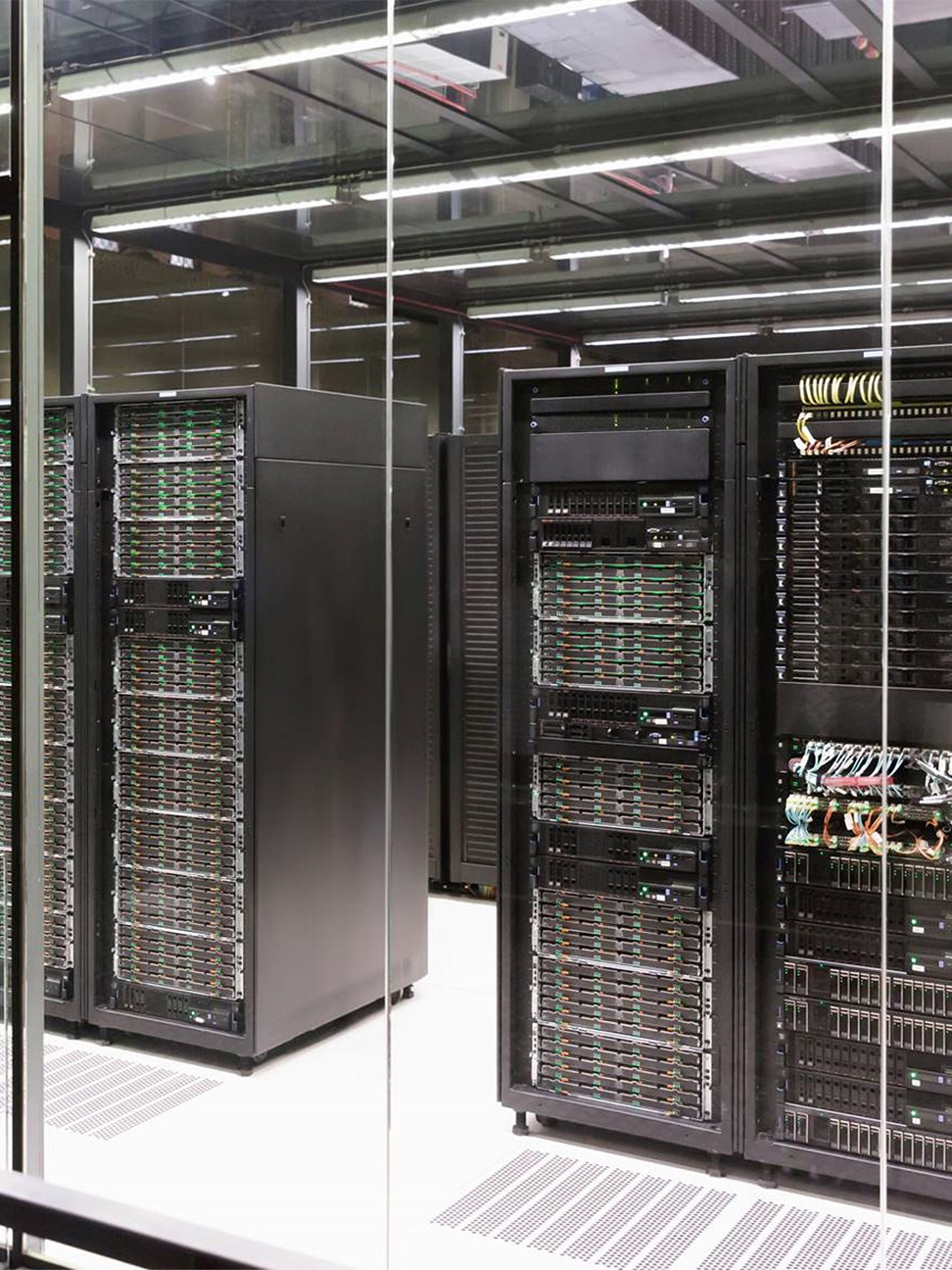Executive Summary
Looking for a PDF of this content?
- A worldwide shortage of available power is inhibiting growth of the global data center market. Sourcing enough power is a top priority of data center operators across North America, Europe, Latin America and Asia-Pacific. Certain secondary markets with robust power supplies stand to attract more data center operators.
- New development is occurring across all four regions despite limited power availability. Northern Virginia remains the world's largest data center market with 2,132 megawatts (MW) of total inventory.
- Despite new development, vacancy rates are declining in all four regions due to strong demand. Singapore—the world’s most power-constrained data center market—has less than 4 MW of available capacity and a record-low vacancy rate of less than 2%.
- Large corporations are finding it increasingly difficult to find enough data center capacity. Low supply, construction delays and power challenges are impacting all markets. For example, Querétaro, Mexico, has only 1.2 MW available for lease.
- The worldwide shortage of available supply is leading to price increases for data center capacity. Singapore has the highest rental rates at $300 to $450 per month for a 250- to 500-kilowatt (kW) requirement, while Chicago has the lowest at $115 to $125.
- The rapid growth of artificial intelligence—along with other modern technologies, such as streaming, gaming and self-driving cars—is expected to drive continued strong data center demand. This will spur innovations in data center design and technology as operators aim to deliver the capacity that meets the increased power density requirements of high-performance computing.

Inventory

North America
Inventory continues to climb, with Northern Virginia leading CBRE’s global rankings. It has 2,132 MW (2.1 GW) of supply, increasing 19.5% year-over-year from Q1 2022 to Q1 2023. Construction costs have generally increased but the Northern Virginia, Silicon Valley, Dallas/Ft. Worth and Chicago markets saw record MW under construction. Higher energy costs have also not materially slowed development, but power availability and bottlenecks are challenges. Local governments are working to address permitting and planning backlogs on transmission projects, particularly as utility companies aim to connect renewable energy to the grid.
Europe
Data center supply grew year-over-year in Frankfurt, London, Amsterdam and Paris (FLAP) as providers work to meet the strong demand across most top European markets. Continued significant data center development and select megaproject deliveries are expected this year, despite power availability issues. However, most new supply will be delivered in London and Frankfurt.
Latin America
There is 672 MW of inventory in Latin America as of Q1 2023, primarily across Brazil, Mexico, Chile and Colombia. The region has experienced significant growth over the past three years, with supply doubling since Q1 2020. Brazil has grown the fastest, with inventory up 127% from 2020 to 2022. It is also the largest, with around 67% of the region’s inventory.
Asia-Pacific
Data center inventory is growing rapidly across Asia-Pacific, achieving impressive scale. Tokyo, Sydney and Singapore each now contain over a half-GW of live power capacity. Sydney’s inventory jumped 30% year-over-year. Lack of power availability is a key emerging challenge facing operators in some Asia-Pacific markets. Overall, operators and investors are optimistic about the region’s potential and are expanding development to markets outside Tier 1 cities.
Figure 1: Inventory (MW)
Source: CBRE Research, Q1 2022 & Q1 2023. Figures and data for North American markets include only wholesale colocation facilities. In Europe, Latin America, and Asia-Pacific, total inventory includes both wholesale and retail colocation facilities.
Vacancy

North America
Vacancy is at a decade low across all major North American markets. Northern Virginia’s available MW decreased from 46.6 MW to 38.4 MW over the past year, despite inventory growing 19.5%. Chicago leads our North America rankings of most significant decrease in vacancy, from 8.2% to 6.7% year-over-year. Despite future power availability uncertainty and elevated power costs, Silicon Valley remains near a record low vacancy at 2.9%.
Europe
Across FLAP markets, the average vacancy rate dropped 4.3% from 17% in Q1 2022 to 12.7% in Q1 2023. Vacancy dropped from 21.6% to 15.3% in London. In Frankfurt, the rate dropped from 8.6% to 4.8%. There will be little relief for occupiers seeking capacity in Europe’s top markets this year. More supply is coming throughout the year, though the vacancy rate is expected to remain low as demand will likely remain strong.
Latin America
The average vacancy rate for Latin America has declined from 12.2% in Q1 2022 to 8.6% in Q1 2023. This trend is most notable in Santiago, where vacancy has moved from 11.7% in Q1 2022 down to 3% in Q1 2023. Querétaro is also showing very tight vacancy at 3.1%. Most of the region’s new inventory has been pre-leased to hyperscalers, with persistent high demand.
Asia-Pacific
Vacancy has declined in most key markets over the past 12 months, except in Sydney, where significant new supply has come online. Singapore has under 4 MW of available leasing space and a record-low vacancy rate of under 2%. Tokyo and Hong Kong have also reduced vacancies by 1.5%, to 2% year-over-year.
Figure 2: Vacancy %
Source: CBRE Research, Q1 2022 & Q1 2023. Figures and data for North American markets include only wholesale colocation facilities. In Europe, Latin America, and Asia-Pacific, total inventory includes both wholesale and retail colocation facilities.
Net Absorption

North America
Leasing activity has shown remarkable resilience despite higher interest rates and economic uncertainty. Strong demand from technology, financial services, healthcare and telecommunications industries contributed to positive absorption. Artificial intelligence is a key focus for Fortune 500 companies, projected to significantly drive future demand. Northern Virginia had 355.6 MW of positive absorption from Q1 2022 to Q1 2023, while Dallas/Ft. Worth, Chicago and Silicon Valley trail significantly at 62.8 MW, 62.5 MW and 45.7 MW, respectively.
Europe
Demand is expected to remain strong despite macroeconomic headwinds. The FLAP markets had a combined 316 MW of positive absorption from Q1 2022 to Q1 2023. Most (256 MW) of that total absorption was in Frankfurt and London. Hyperscalers are trying to stay ahead of demand for their services, procuring large tranches of capacity from data center operators. They are doing this by expanding their availability zones, where public cloud service providers operate within distinct geographic areas that offer high-speed fiber network connectivity.
Latin America
In Q1 2023, net absorption declined slightly year-over-year to 62.2 MW, though demand across Latin America remained robust. Net absorption in Latin America has more than doubled since 2020, when the market absorbed 61 MW, almost 20% of the total Inventory. Lack of digital infrastructure development during the previous 10 years has prompted public and private entities to invest in connectivity, data storage and internet access. This digital transformation has led to strong net absorption and higher subsequent adoption of cloud services.
Asia-Pacific
Despite macroeconomic headwinds and rationalization in the global technology sector, Asia-Pacific leasing activity remains resilient. There is continued demand across industry verticals as businesses and governments move towards digitalization. Sydney led in net absorption with over 99 MW leased. Tokyo has 43 MW of net absorption. Activity levels in Singapore and Hong Kong were more muted at just over 21 MW each. Emerging markets such as Mumbai and Seoul also recorded take-up growth.
Figure 3: Net Absorption from Q1 2022 to Q1 2023 (MW)
Source: CBRE Research, Q1 2022 & Q1 2023. Figures and data for North American markets include only wholesale colocation facilities. In Europe, Latin America, and Asia-Pacific, total inventory includes both wholesale and retail colocation facilities.
Pricing & Rental Rates

North America
Pricing in North America continued trending up in Q1 2023 because the region is significantly supply constrained. There is not enough available space to satisfy specific needs from different customers. Lack of power availability, expensive land, high materials and labor costs and supply chain delays have slowed new construction completion. Rental rates stabilized in 2021 and have consistently trended up, as of Q1 2023. In the past year, Silicon Valley pricing experienced the most significant year-over-year increase, with the highest rates in North America.
Europe
Pricing has steadily increased in the top European markets, given strong demand and higher build and operational costs. Those factors caused rental rates to climb over the past 18 months. Rates are highest in Frankfurt and London. Operators have had to pass the higher operational and build costs on to their customers by increasing rental rates. Lack of available inventory in Europe’s largest markets is another key factor contributing to higher rates.
Latin America
Colocation rental rates in Latin America are rising due to greater data center services demand. Pricing is notably higher in Latin America compared with more mature Western markets in North America and Europe. Limited supply, high fees and taxes are important factors causing rental rate increases.
Asia-Pacific
Colocation rental rates in Asia-Pacific remain strong, despite major new inventory development and macroeconomic uncertainty. Singapore is one of the most expensive markets globally, at over USD $300 per kW, while Tokyo prices are holding steady around USD $200 per kW. Sydney colocation rates are amongst the most competitive in Asia-Pacific, though still within an attractive band for new operators and investors to enter that market.
Figure 4: Monthly Pricing Range for 250-500kW (Min-Max) $USD Without Electricity Cost
Source: CBRE Research, Q1 2022 & Q1 2023. Figures and data for North American markets include only wholesale colocation facilities. In Europe, Latin America, and Asia-Pacific, total inventory includes both wholesale and retail colocation facilities.
Availability

North America
Data centers have shown tremendous resilience compared with other asset classes. Enormous growth in supply from Q1 2022 to Q1 2023 was met with strong demand, resulting in leasing availability reduction of -8.2 MW in Northern Virginia. Dallas/Ft. Worth and Chicago were not far beyond, with only +0.2 MW and +0.5 MW of increased availability. In Silicon Valley, leasing availability rose only slightly, at +6.8 MW.
Europe
Leasing availability decreased 17% across FLAP from Q1 2022 to Q1 2023. Power capacity remains scarce in top European markets and is harder to source. The data center industry’s largest customers are securing power capacity at such an increasing volume that it’s outpacing completed development. Hyperscalers are attempting to ensure they can meet the anticipated future demand for their digital services. They must increase their digital footprints for adequate future performance and reliability.
Latin America
São Paulo leads the region with 52.3 MW of leasing availability in Q1 2023, down from 69 MW in Q1 2022. 70 MW is available in core markets (São Paulo, Santiago, Querétaro and Bogotá), which is distributed among legacy and new-build enterprise assets that offer colocation services. It can be challenging to meet the demands of organizations that require over 1 MW due to some countries’ limited available leasing space.
Asia-Pacific
Data center availability in Asia-Pacific remains healthy, with growing demand across most markets absorbing new supply. Inventory in Singapore remains constrained, with few developments in progress after a government-imposed moratorium. Sydney is experiencing a wave of new supply. CBRE expects robust demand across the region for the foreseeable future, despite current challenges. This will attract operators to build new capacity, ensuring colocation availability for both cloud service providers and enterprises.
Figure 5: Availability (MW)
Source: CBRE Research, Q1 2022 & Q1 2023. Figures and data for North American markets include only wholesale colocation facilities. In Europe, Latin America, and Asia-Pacific, total inventory includes both wholesale and retail colocation facilities.
North America Featured Markets
Northern Virginia
Over 90% of Virginia data centers are in Loudoun County, Prince William County and Fairfax County. Strong demand and supply constraints in Q1 caused vacancy in Northern Virginia to remain near a record low of 1.8%. Electricity rates in Northern Virginia remain steady, despite power availability headwinds. Information provided by Dominion Energy reveals that power availability issues are reflective of transmission and distribution issues, not power generation. There is significant new development despite power challenges, and hyperscaler demand has enticed new operators.
This region significantly benefits from nuclear power. Approximately 34% of the power supply for electricity is sourced via nuclear plants. If significant resources are invested into nuclear energy, this may contribute to easing future power availability issues in five to 10 years.
Opportunities
There is more power capacity availability outside Northern Virginia, such as in Central Virginia. Developers and operators have the opportunity to increase development along I-95 to Fredericksburg and Richmond. Maryland and other adjacent Virginia counties could see an uptick in development too.
Challenges
Power supply concerns raise questions about future development, but the bottleneck should ease by 2025 or 2026.

~34% of the power supply for electricity is sourced via nuclear plants
Silicon Valley
Aided by technology industry proximity, Silicon Valley has been an ideal location for innovative companies seeking colocation data center space. Silicon Valley Power, the main utility provider for Santa Clara, historically offered meaningfully discounted power rates to utility provider PG&E in neighboring cities. This boosted data center development as providers aimed to save energy costs.
Recently, power availability constraints and inflated land prices have caused providers to explore new development in further neighboring areas, like the East Bay. Asking rental rates in the 250 to 500 kW range have risen to $155 to $250 per kW, the highest of all North American markets in our report. However, vacancy remained near historical lows at 2.9% during Q1. In terms of water supply, a record-setting snowpack has temporarily eased drought conditions throughout Northern California. This is a relief for facilities with liquid cooling, as opposed to air cooling.
Opportunities
Expansion into new local markets could provide a solution for Santa Clara’s and Silicon Valley Power’s capacity issues. Continued progress and innovation among local technology companies could lead to additional capacity demand.
Challenges
Land prices have increased substantially in the last five years. There is a lack of available land and rental rates are higher than other major North American markets. Many new substations will not energized until 2028 to 2029.

2.9% vacancy remained near historical lows during Q1
Dallas/Ft Worth
Dallas/Ft. Worth remains one of North America’s most popular markets for data center development. Currently, a record setting 323.9 MW are under construction, with 88.4% of capacity preleased. Last year saw an 850% increase over the normal leasing activity in Dallas. Also, total inventory rose 17% year-over-year, from Q1 2022 to Q1 2023. This resulted in Dallas/Ft. Worth recently surpassing Silicon Valley as the nation’s second-largest colocation data center market.
Texas has optimized its power transmission and distribution process while many states have had delays. ERCOT, the energy grid servicing most of Texas, operates entirely within the state. This presents a streamlined process for independent decision-making and execution. ERCOT also has vulnerabilities, highlighted during the winter freeze of 2021, which caused wind turbines to fail, resulting in severe shortages and delays.
Opportunities
ERCOT’s and Oncor Electric’s available power enabled a shorter timeline than many other major markets for development. Mean-while, those other markets face supply chain and power supply de-lays. Developer demand has been strongest in South Dallas.
Challenges
There is speculation about if demand can continue to meet supply expectations, as construction and inventory surpass all-time highs.

850% increase over the normal leasing activity in Dallas
Chicago
Hyperscalers and enterprise operators remain interested in Chicago. Technology, finance and healthcare industries continue to drive strong demand in enterprise data center activity. While inventory grew 20.6% year-over-year from Q1 2022 to Q1 2023, available lease space declined 2% year-over-year. This reflects an updated vacancy rate of 6.7%. Many developers are competing for power capacity on the same existing and newly constructed substations. Large power deliveries will require 3 to 5 years to complete. Land availability continues to be extremely limited in the O’Hare market and land prices remain stable despite broader macroeconomic conditions. Demand from both data center developers and institutional industrial developers remains strong.
Opportunities
Chicago benefits from its size, location and demand from cloud service providers (CSP). It’s strategically situated in the Midwest and is the U.S.’s third-most populous city. CSPs prefer close proximity to end-users, so Chicago is expected to see additional demand.
Challenges
Available and affordable land for development is a main challenge. Additionally, power rates at $0.065 to $0.07 are higher than alternative markets.

2% decline in available space year-over-year
EMERGING MARKET
Austin, Texas
Located in the “Texas Triangle” along with Dallas/Ft. Worth and Houston, Austin has emerged as one of North America’s fastest-growing data center markets. Hutto, Pflugerville, Round Rock and Taylor in North Austin have seen impressive new activity in the past five years. The Samsung semiconductor fabrication campus in Taylor received the largest foreign investment of any real estate project in Texas history, reflecting the interest level in data centers. Additionally, Round Rock is home to Dell’s corporate headquarters.

EMERGING MARKET
Charlotte, North Carolina
Impressive power capacity, availability and affordable land are top reasons hyperscaler demand will continue growing in this region. Advantageously situated between Northern Virginia and Atlanta, Charlotte benefits from great connectivity along the East Coast. The development of subsea cables in Myrtle Beach, connecting to Europe and Latin America, are expected to be completed in 2023 to 2024.

Europe Featured Markets
Frankfurt, Germany
Demand in Frankfurt is mostly driven by hyperscalers, CSPs and, secondarily, by international enterprises and content providers.
Recent regulatory issues have significantly impacted this market’s data center industry. Pending legislation would mandate how local data centers are run, including required operating temperature ranges. Higher required operating temperature ranges in data centers may cause equipment to fail or malfunction. German regulators also want data centers to harness excess heat for warming residential homes. These potential requirements have major cost implications and would significantly impact how local facilities are designed and operated. This legislation, introduced last year, was preceded by the City of Frankfurt’s plan to limit developments to certain neighborhoods where data centers are already located. Despite this, significant demand for capacity in the financial capital of Germany persists.
Opportunities
Operators in search of power, available land and potentially lower taxes are considering municipalities outside of Frankfurt like Hanau, Rüsselsheim and Groß-Gerau, despite higher power prices. A lack of suitable land in more heavily developed submarkets of Frankfurt and advancements in connectivity have made areas further afield an option.
Challenges
A still-pending new energy efficiency law could complicate data center providers’ operations by increasing compliance costs, adding significant expense to doing business in the city. Also, operators that did not secure fixed prices last year before energy prices jumped have incurred significantly higher power costs and could suffer a worsened competitive position.

Vacancy is at an all-time low in Frankfurt
London, United Kingdom
A variety of large developments are projected to be delivered this year. Europe’s largest colocation data center market has grown consistently, especially in West London. Demand for capacity remains relatively high compared to other European markets, given hyperscalers’ presence in the region. This demand is also due to proximity to world-class London-based organizations and London’s prime location for reaching the Americas via subsea cables. Providers are delivering supply at record or near-record rates most years, yet vacancy is declining.
Providers will need to secure additional power to sustain growth, a growing issue in the region. However, power at key electricity substations for data center operators is in scarce supply. Organizations could seek data center capacity further from London in the future.
Opportunities
CBRE expects operators to make data centers further from availability zones in West London feasible for hyperscalers. There may be additional development in submarkets adjacent to Slough, the location of many hyperscalers’ availability zones.
Challenges
Power is increasingly difficult to secure in London from the transmission system operator. Moreover, a key electricity substation upgrade in the western corridor has been delayed. As a result, securing power from the grid operator is almost impossible for the next few years. This is a problem for the hyperscalers, given their desire to expand their availability zones in the western corridor.

Vacancy dropped from 21.6% to 15.3% from Q1 2022 to Q1 2023 in London
Amsterdam, Netherlands
Amsterdam is poised for growth through 2023, despite a high-profile moratorium on large data center builds implemented last year. Amsterdam is still attractive to many corporations utilizing technology, given its history of hosting organizations in connectivity-rich facilities. However, the market is not growing at the rate of its FLAP and Dublin peers. A national moratorium on large-scale data centers and a lack of power for new facilities is hindering development.
Consequently, Amsterdam finds itself in greater competition for data center developers and their customers. The market has grown consistently over the past five years, albeit not at the same rate as London and Frankfurt. Moreover, there will be considerably more capacity added in Paris than Amsterdam this year despite the opening of a large build-to-suit facility in Amsterdam.
Opportunities
Amsterdam providers can potentially position the market as a hub for edge solutions. Amsterdam is well situated and has connectivity-rich facilities that can potentially be used for this. Smaller hyperscaler deployments that help move latency-sensitive workloads may be a great way to bring improved performance to end users.
Challenges
Securing power is a challenge in Amsterdam, like in every major European market. It is particularly difficult to develop land for data centers in Schiphol, the Amsterdam region that contains notable hyperscaler availability zones. A key electricity substation in the submarket will not be upgraded for years, which could lead organizations to look else-where for capacity. As a result, Amsterdam may also not be seen as an ideal market for providers planning to build new facilities. Another notable market impediment is the national moratorium on data centers of over 70 MW in IT load.

Amsterdam's supply base will grow this year, though not at the rate of most FLAP and Dublin peers
Paris, France
The expected growth of the Paris market is more in line with London's and Frankfurt's this year. Only Frankfurt is expected to grow new supply more than the French capital in 2023. The regional market is expanding because there is a large and arguably under-served group of French corporates from the aviation, insurance, cosmetics, energy and professional services sectors seeking more data center services. South Paris is expected to see most new development now and over the next few years, as providers work to meet hyperscalers’ and enterprises’ needs. This is due to more suitable and affordable land, as well as less severe power constraints in South Paris than in the North. Existing fiber infrastructure connectivity is more common in South Paris.
Opportunities
Hyperscalers are increasing investment in Paris to better serve France and adjacent markets with its excellent transport and network connectivity routes. As a result, there is growing demand for cloud services from hyperscalers and an announced national cloud strategy by the national government. This led many companies in Paris to build remote communications infrastructure and adopt a cloud focused IT strategy.
Challenges
Developing data centers in North Paris is extraordinarily difficult due to a lack of suitable land and available power. The zoning restrictions implemented for the 2024 Olympics compound issues for providers and others seeking to build in this region.

The Paris market will grow due to large, new data centers under construction in the South
EMERGING MARKET
Johannesburg, South Africa (EMEA Market)
This South African city is by far the most mature African market in terms of total supply. The market represents almost half (147 MW) of total installed capacity (328 MW) in Africa, which has a population of 1.4 billion people. South Africa is the only African country with cloud regions. Hyperscalers first introduced cloud services in Johannesburg, with Microsoft initiating this in 2019. South Africa, like European countries, has a power availability issue. Transmission provider Eskom has imposed load-shedding of up to 12 hours a day due to a generating capacity shortage. This is mainly due to the expected delivery of supply from a select group of providers.

EMERGING MARKET
Milan, Italy
Milan is one of the fastest growing markets in Europe because it has more power and land available than many markets, allowing new entrants to construct large data centers. Moreover, government policy aims to encourage investment in cloud services and data storage within Italy. Finally, subsea cables connect Italy to the rest of the Mediterranean and North Africa—with direct land-based fiber connectivity to Milan. This makes Milan a key connectivity hub because its close proximity to subsea cables enables lower latency to international destinations. Hyperscale-suitable capacity is projected to grow dramatically: the market will nearly double from Q1 2023 to Q4 2024. This is mainly due to the expected delivery of supply from a select group of providers.

Latin America Featured Markets
São Paulo, Brazil
São Paulo is attracting developer-operators because it’s the largest, most populated and wealthiest market in Brazil, and the largest in Latin America. The region offers low latency, excellent connectivity and robust infrastructure for enterprises needing capacity. There is already a high concentration of IT services offered in São Paulo, which makes it a suitable location for data centers. The market is dominated by wholesalers whose capacity is typically taken by hyperscalers. However, there are several retail providers in the market as well.
Opportunities
The area is well-connected with many Internet Exchange Points. Its proximity to major international regional company offices and B3, the Brazilian stock exchange, makes it a prime location for additional development.
Challenges
Some existing local operators have banked land and power for expansion plans, reducing site development time. New entrants can expect higher land prices as more regional projects emerge. Additionally, many properties are unsuitable for data center development due to lack of utilities and fiber connectivity, which may further complicate the development process and require careful evaluation for site selection. Finally, providers must contend with complex and time-consuming regulatory and licensing requirements.

A high concentration of IT services are offered in in São Paulo, making it a suitable location for data centers
Santiago, Chile
Santiago is the focal point of data center activity in Chile, given its large population and concentration of corporate headquarters. Major international firms like Google have established data centers in the area. Retail and telecom data centers are downtown, while hyperscale and wholesale facilities are in North Santiago. Water usage and hazardous waste disposal are specific environmental concerns extending development timelines in the area. The total inventory of 109 MW has grown in the last few years as more operators seek to take advantage of the submarine cables connecting the region with North America and future connectivity with Asia-Pacific.
Opportunities
Chile plans to connect to Asia-Pacific markets through a trans-Pacific submarine cable, taking advantage of its strategic geographic location. Chile benefits from consistently strong winds in Patagonia and the Atacama Desert provides plentiful sunlight. Chile has set an ambitious goal of converting 70% of its total energy consumption to renewables by 2030. These initiatives are helping to reduce reliance on copper mining and fossil fuels. South Santiago has untapped potential for data center growth, as inventory remains low. Hyperscale activity also remains strong.
Challenges
Challenges include insufficient energy supply in certain areas and the risk of natural disasters such as earthquakes and flooding. The site selection process is often lengthy, given the time needed to obtain environmental licenses. Additionally, too little land is approved for development. Water consumption concerns further complicate the process.

70% of total energy consumption is to be converted to renewables by 2030
Querétaro, Mexico
Querétaro is the most preferred location for data center development in Mexico. Its proximity to Mexico City and the booming Bajío region fuels business growth. There are multiple municipalities that house data centers in the region. It also contains over 76 industrial parks and many of the country’s largest banks’ data centers. The state serves as a crucial Internet backbone that connects Mexico City and the United States. It has attracted significant investments from top cloud service providers.
Opportunities
Querétaro has been experiencing significant IT and tech industry growth, driven by a favorable business environment, government support and a skilled workforce. Increasing demand for data center services has followed. Data center acquisitions and ongoing projects reflect this rising interest. Industrial park land prices remain competitive compared to other municipalities. The region has relatively lower risk of natural disasters such as hurricanes and earthquakes.
Challenges
The region’s increasing power demand is posing challenges for the Federal Electricity Commission (CFE) to meet energy needs in Querétaro. Furthermore, the presence of local ongoing hyperscale projects creates competition for the same power. There has been a surge in the power capacity sold in industrial parks, leading to delays in delivering power to recently built data centers. Additionally, data center providers based in Mexico City are actively pursuing opportunities in Querétaro, further intensifying local competition.

The state serves as a crucial Internet backbone that connects Mexico City and the United States
Bogotá, Columbia
The capital of Colombia is attracting more data center development, given its large and relatively well-paid population. Available data center inventory is limited but the region is very well connected with other locales in Latin America and North America, and very open to foreign investment. The data center market size is not proportional to the population and size of the economy, creating an investment opportunity. Free-trade zones play an important role in the market as there are potential tax benefits for tenants.
Opportunities
Bogotá, the largest data center market in Colombia, is experiencing remark-able construction growth because established operators are expanding their data centers to meet rising demand. However, land alternatives are becoming scarce, making acquisitions within free-trade zones highly advantageous. Very few hyperscale data centers are currently operational in this market, but many would-be customers are seeking the IT services these data centers would provide.
Challenges
Land scarcity within free-trade zones hampers data center demand. Project timelines may be prolonged due to lengthy approval processes. The market's rapid growth poses potential energy availability challenges. Competition with established players and higher industrial development prices further impact the market.

The largest data center market in Colombia is experiencing remarkable construction growth
EMERGING MARKET
Lima, Peru
A majority of data centers in Lima have less than 2 MW leasing availability. However, Peru's IT sector is growing quickly due to greater adoption of cloud computing and digital transformation initiatives. This growth has led to higher demand for data center services, creating greater opportunities for data center operators. Despite political instability, Peru's strategic location, stable economy and improving infrastructure make it an attractive market.

EMERGING MARKET
Montevideo, Uruguay
Uruguay's data center market, although small, benefits from its strategic position near Buenos Aires and Brazil. Uruguay boasts a stable economy, exceptional connectivity and an electricity fuel mix heavily weighted to renewable energy (particularly hydropower and wind). CBRE expects continued interest from cloud service providers and data center operators.

Asia-Pacific Featured Markets
Singapore
As one of the world’s most sought-after data center markets, Singapore has less than 2% vacancy. Limited power supply and high sustainability requirements are the main reasons why Singapore’s inventory is expected to remain tight and colocation pricing to remain elevated over the next few years. This is despite 60 MW of potential new capacity to be introduced by the government under the pilot Data Center-Call for Application (DC-CFA) exercise. In recent months, this has pushed demand for IT capacity to nearby locations, such as Johor in Malaysia. Keppel Data Centers, a local data center operator, has called for at least 1 GW of new data center capacity, supplied by a hydrogen-based green energy grid.
Opportunities
Singapore is a key Asia-Pacific data center hub due to its political stability, robust digital infrastructure and connectivity and a technology-industry friendly business environment.
Challenges
More stringent sustainability-related conditions for data center development will lead to higher requirements and costs for potential data center operators and investors.

<2% vacancy due to limited power supply and high sustainability requirements
Tokyo, Japan
Tokyo continues to attract significant investor and occupier interest as a key Asia-Pacific data center location. Data center vacancy rates for greater Tokyo stood at just above 10% as of Q1 2023. Demand is expected to remain robust even as new inventory is set to expand around 30% by 2025. This growth is fueled by the country’s increasing use of cloud-based services and the expansion of global cloud service providers. The government encourages data center development in regional areas such as Osaka, Fukuoka and Hokkaido as part of its vision for a “digital garden city nation."
Opportunities
Demand for data center capacity in Tokyo remains robust. Local companies’ cloud-based services usage is growing, driving up regional cloud demand. The expansions by global cloud providers in greater Tokyo (and beyond) indicate that supply and demand conditions will remain tight.
Challenges
Land and power constraints around greater Tokyo mean higher costs and potential delays for new developments—as well as intense competition from domes-tic and international players.

>10% Data center vacancy rates for greater Tokyo as of Q1 2023
Hong Kong
Demand in Hong Kong remains subdued despite the city’s post-pandemic reopening, and with expansionary requirements from mainland Chinese cloud providers and enterprises. Vacancy inched down slightly while rates remain under pressure. Some customers are tapping into near-term market weakness to secure more favorable terms in higher quality assets, in anticipation of tightening inventory after 2024. Hong Kong’s inventory pipeline continues to be driven by the redevelopment or renovation of older industrial buildings, with the government potentially introducing new land supply in the medium-term for data center development.
Opportunities
With colocation demand subdued and pricing under pressure, there remains opportunities for data center occupiers and investors to negotiate favorable terms for assets in Hong Kong. Demand is likely to pick up in the medium term as Chinese and foreign companies return.
Challenges
Western companies have become more hesitant to establish or expand data center footprints due to heightened geopolitical concerns.

Vacancy inched down slightly while rates remain under pressure
Sydney, Australia
Traditionally one of the key Asia-Pacific data center hubs, Sydney has recently seen a “second wave” of interest from global cloud service providers, operators and investors. Its year-over-year vacancy increase was in line with new inventory added to the market. Medium-term pricing pressure is expected due to a large planned pipeline of around double the existing market supply. Nevertheless, new sources of demand from gaming, content streaming, industrial IoT applications and AI are expected to mitigate some of this risk. CBRE expects Sydney to remain a resilient data center market in the region.
Opportunities
The Sydney data center market is resilient, with renewed interest from hyperscale cloud service providers and investors. As other Asia-Pacific data center markets experience con-strained growth, Sydney is a decent alternative to meet regional demand.
Challenges
Large planned and upcoming inventory in Sydney could mean limited upside in colocation pricing over the medium term, and potential risks for leasing.

Year-over-year vacancy increase was in line with new inventory added to the market
EMERGING MARKET
Mumbai, India
Mumbai is India’s largest data center market at over 300 MW, accounting for over 40% of total capacity. Data center inventory in Mumbai is expected to more than double over the next two years. This strong demand is particularly driven by financial services companies, a good ecosystem of fiber connectivity and government support. Established domestic and global operators are expanding in the market, and a major hyperscale cloud provider recently acquired over 50 acres of land on the city's edge. Other international investors with planned developments in greater Mumbai include Blackstone, Brookfield-Digital Realty and Princeton Digital Group.

EMERGING MARKET
Seoul, South Korea
Previously dominated by domestic telecom companies and Korean conglomerates, international data center operators are now gaining a foothold in Korea through partnerships. The primary data center market of greater Seoul broadly includes the regions of Gyeonggi (Anyang/Pyeo-ngchon, Bundang/Pangyo and Ilsan) and Incheon, which comprises most of the country’s data center capacity. There are major developments underway in South Korea by international operators such as Actis, Digital Edge, SC Zeus, STT GDC and Stack Infrastructure.

Related Insights
- Report | Intelligent Investment
North America Data Center Trends H2 2022
February 17, 2023 10 Minute Read

The data center market remains in favor, but power constraints and higher costs are major headwinds.
Related Services
Optimize your data center real estate with worldwide consulting, advisory and transaction, project management an...
North America
Latin America
Asia Pacific
Insights in Your Inbox
Stay up to date on relevant trends and the latest research.








